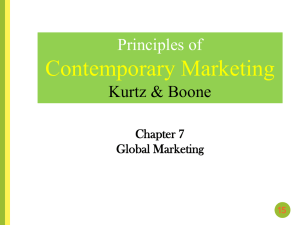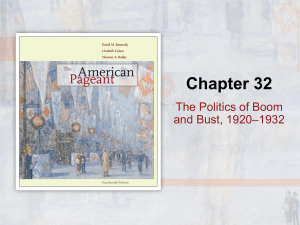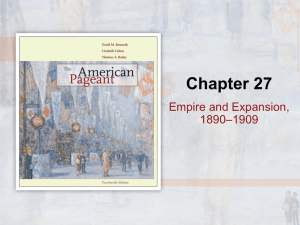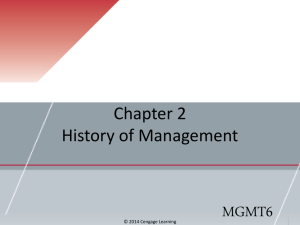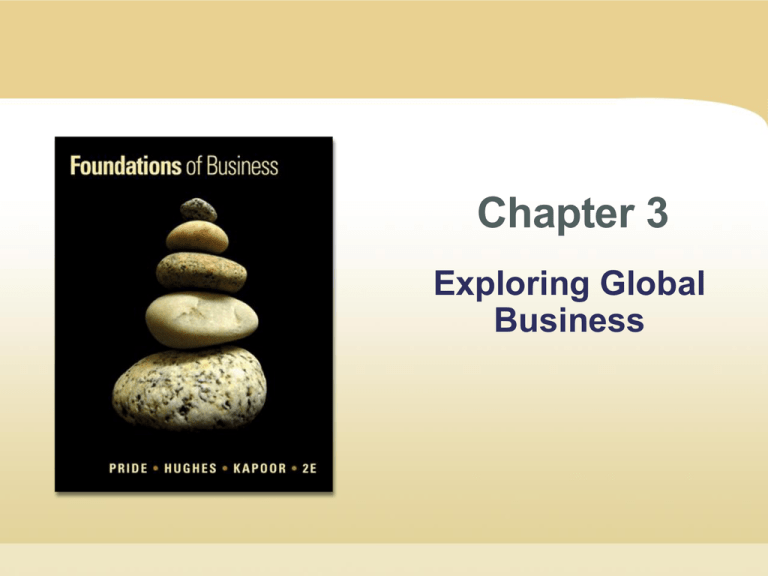
Chapter 3
Exploring Global
Business
Learning Objectives
1. Explain the economic basis for international business.
2. Discuss the restrictions nations place on international
trade, the objectives of these restrictions, and their
results.
3. Outline the extent of international trade and identify the
organizations working to foster it.
4. Define the methods by which a firm can organize for
and enter into international markets.
5. Describe the various sources of export assistance.
6. Identify the institutions that help firms and nations
finance international business.
Copyright © Cengage Learning. All rights reserved.
Chapter 3 | Slide 2
International Business
…all business activities that involve
exchanges across national boundaries.
Copyright © Cengage Learning. All rights reserved.
Chapter 3 | Slide 3
Absolute Advantage
…the ability to produce a specific product
more efficiently than any other nation.
Copyright © Cengage Learning. All rights reserved.
Chapter 3 | Slide 4
Comparative Advantage
…the ability to produce a specific product more
efficiently than any other product.
Copyright © Cengage Learning. All rights reserved.
Chapter 3 | Slide 5
Exporting
…selling and shipping raw materials or
products to other nations.
Copyright © Cengage Learning. All rights reserved.
Chapter 3 | Slide 6
Importing
…purchasing raw materials or
products in other nations and
bringing them into one’s own country.
Copyright © Cengage Learning. All rights reserved.
Chapter 3 | Slide 7
Why This Chapter Matters
Free trade—are you
for or against it?
Most economists
support free-trade
policies, but public
support can be
lukewarm, and
certain groups
are adamantly
opposed, alleging
that “trade harms
large segments
of U.S. workers,”
“degrades the
environment,” and
“exploits poor
countries.”
Copyright © Cengage Learning. All rights reserved.
Chapter 3 | Slide 8
Exporting and Importing
U.S. Exports
Excess
Corn
Excess
Wine
U.S. Imports
Copyright © Cengage Learning. All rights reserved.
Chapter 3 | Slide 9
Figure 3.1: The Top Ten Merchandise
Exporting States
Source: http://www.ita.doc.gov/td/industry/otea/state/2005_year_end_dollar_value_05.html,
accessed May 2, 2009.
Copyright © Cengage Learning. All rights reserved.
Chapter 3 | Slide 10
Figure 3.2: U.S. International Trade in
Goods and Services
Source: U.S. Department of commerce, International Trade Administration, U.S. Bureau of Economic Analysis,
http://bea.gov/international/bp_web/action.cfm, accessed April 16, 2009.
Copyright © Cengage Learning. All rights reserved.
Chapter 3 | Slide 11
Balance of Trade
…the total value of a nation’s exports
minus the total value of its imports over
some period of time.
Imports > Exports = (-) Balance of Trade
Exports > Imports = (+) Balance of Trade
Copyright © Cengage Learning. All rights reserved.
Chapter 3 | Slide 12
Trade Deficit
…negative balance of trade.
Spotlight
Source: U.S. Department of Commerce, Bureau of Economic Analysis,
http://www.bea.gov/international/index.htm#bop, accessed May 1, 2009.
Copyright © Cengage Learning. All rights reserved.
Chapter 3 | Slide 13
Balance of Payments
…the total flow of money into a country
minus the total flow of money out of that
country over some period of time.
Includes
•
•
•
•
•
•
Imports and exports
Investments
Money spent by foreign tourists
Payments by foreign governments
Aid to foreign governments
All other receipts and payments
Copyright © Cengage Learning. All rights reserved.
Chapter 3 | Slide 14
Trade Restrictions ─ Tariff
Import duty
tax levied on a particular foreign product
entering a country
Revenue
imposed solely to generate income
Protective
imposed to protect domestic industry from
competition
Copyright © Cengage Learning. All rights reserved.
Chapter 3 | Slide 15
Trade Restrictions ─ Dumping
…exportation of large quantities of a
product at a price lower than that of the
same product in the home market.
Copyright © Cengage Learning. All rights reserved.
Chapter 3 | Slide 16
Trade Restrictions ─ Nontariff
…a nontax measure imposed
by a government to favor domestic
over foreign suppliers.
Import Quota
Embargo
Foreign-Exchange Control
Currency Devaluation
Copyright © Cengage Learning. All rights reserved.
Chapter 3 | Slide 17
Reasons for Trade Restrictions
Equalize nation’s balance of payments
Protect new/weak industries
Protect national security
Protect health of citizens
Retaliate for another nation’s trade restrictions
Protect domestic jobs
Copyright © Cengage Learning. All rights reserved.
Chapter 3 | Slide 18
Reasons Against Trade Restrictions
Higher prices for
consumers
Restriction of consumers’
choices
Misallocation of
international resources
Loss of jobs
Copyright © Cengage Learning. All rights reserved.
Chapter 3 | Slide 19
World Economic Outlook for Trade
Canada and Western
Europe
Mexico and South
America
Japan
Developing Asia
Central/Eastern
Europe and Russia
Copyright © Cengage Learning. All rights reserved.
Chapter 3 | Slide 20
Exports and U.S. Economy
Opportunity for all
countries
Exports more important to
U.S. economy
Canada and Mexico best
export partners
Canada and China best
import partners
Copyright © Cengage Learning. All rights reserved.
Chapter 3 | Slide 21
Figure 3.3: U.S. Goods Export and Import
Shares in 2008
Source: Federal Reserve Bank of St. Louis, National Economic Trends, May 2009, p. 18,
http://research.stlouisfed.org/publications/net/page18.pdf , accessed May 1, 2009.
Copyright © Cengage Learning. All rights reserved.
Chapter 3 | Slide 22
Table 3.1: Global Growth Remains Sluggish
Growth has been led by developing countries and emerging markets.
Source: International Monetary Fund: World Economic Outlook by International Monetary Fund.
Copyright 2009 by International Monetary Fund. Reproduced with permission of International Monetary
Fund via Copyright Clearance Center.
Copyright © Cengage Learning. All rights reserved.
Chapter 3 | Slide 23
Table 3.2: Value of U.S. Merchandise
Exports and Imports, 2008
Source: U.S. Department of Commerce, International Trade Administration,
http://www.stumbleupon.com/s/#4Y3NJR/ita.doc.gov/td/industry/otea/ttp/Top_Trade_Partners.pdf/topic:UK , accessed
May 1, 2009.
Copyright © Cengage Learning. All rights reserved.
Chapter 3 | Slide 24
General Agreement on
Tariffs and Trade (GATT)
…an international organization of 132
nations dedicated to reducing or eliminating
tariffs and other barriers to world trade.
Copyright © Cengage Learning. All rights reserved.
Chapter 3 | Slide 25
GATT-Sponsored Negotiations
Kennedy Round
(1964–1967)
Tokyo Round
(1973–1979)
Uruguay Round
(1986–1993)
Doha Round
(2001+)
Copyright © Cengage Learning. All rights reserved.
Chapter 3 | Slide 26
World Trade Organization
…powerful successor to GATT that
incorporates trade in goods, services, and
ideas.
Membership
Obliges 149 members to observe GATT
Has judicial powers to mediate among members
disputing new rules
Has more binding authority than GATT
Copyright © Cengage Learning. All rights reserved.
Chapter 3 | Slide 27
Economic Community
…an organization of nations formed to
promote the free movement of resources and
products among its members and to create
common economic policies.
Copyright © Cengage Learning. All rights reserved.
Chapter 3 | Slide 28
International
Economic Communities
European Union
European Economic Area
North American Free Trade Agreement
(NAFTA)
Central American Free Trade Agreement (CAFTA)
Association of Southeast Asian Nations
(ASEAN)
Commonwealth of Independent States (CIS)
(cont.)
Copyright © Cengage Learning. All rights reserved.
Chapter 3 | Slide 29
International
Economic Communities (cont.)
Caribbean Basin Initiative (CBI)
Common Market of the Southern Cone
(Mercosur)
Organization of Petroleum Exporting Countries
(OPEC)
Economic Community of West African States
(ECOWAS)
Organization of Economic Cooperation and
Development (OECD)
Copyright © Cengage Learning. All rights reserved.
Chapter 3 | Slide 30
Figure 3.4: The Evolving European Union
Source: http://europa.eu/abc/european_countries/index_en.htm, accessed May 2, 2009.
Copyright © Cengage Learning. All rights reserved.
Chapter 3 | Slide 31
Methods of Entering International Business
Copyright © Cengage Learning. All rights reserved.
Chapter 3 | Slide 32
Licensing
…a contractual agreement in which one firm
permits another to produce and market its
product and use its brand name in return for a
royalty or other compensation.
Copyright © Cengage Learning. All rights reserved.
Chapter 3 | Slide 33
Exporting
Manufacture products in home country and export
them to foreign markets
Relative low risk
Export-import merchant
Documents
• Letter of credit
• Bill of lading
• Draft
Copyright © Cengage Learning. All rights reserved.
Chapter 3 | Slide 34
Joint Ventures
…a partnership formed to achieve
a specific goal or to operate for a
specific period of time.
Copyright © Cengage Learning. All rights reserved.
Chapter 3 | Slide 35
Totally Owned Facilities
…a firm’s own production and marketing facilities,
developed in one or more foreign nations as a
direct investment.
Copyright © Cengage Learning. All rights reserved.
Chapter 3 | Slide 36
Forms of Direct Investment
$ Builds/purchases manufacturing and other
facilities in the foreign country, produces/markets
own established products in foreign/neighboring
countries
$ Purchases existing firm in foreign country
under arrangement allowing it to operate
independently of parent company
Copyright © Cengage Learning. All rights reserved.
Chapter 3 | Slide 37
Strategic Alliance
…a partnership formed to create competitive
advantage on a worldwide basis.
Copyright © Cengage Learning. All rights reserved.
Chapter 3 | Slide 38
Trading Company
…a company that provides a link between
buyers and sellers in different countries and
is not involved in manufacturing or owning
assets related to manufacturing.
Copyright © Cengage Learning. All rights reserved.
Chapter 3 | Slide 39
Countertrade
…an international barter transaction
in which goods and services are exchanged
for different goods and services.
Copyright © Cengage Learning. All rights reserved.
Chapter 3 | Slide 40
Multinational Enterprise
…a firm that operates on a worldwide scale
without ties to any specific nation or region,
representing the highest level of involvement in
international business.
Copyright © Cengage Learning. All rights reserved.
Chapter 3 | Slide 41
Value of U.S. Merchandise Exports and
Imports, 2008
Source: U.S. Department of Commerce, International Trade Administration,
http://www.ita.doc.gov/td/industry/otea/ttp/Top_Trade_Partners.pdf, accessed May 1, 2009.
Copyright © Cengage Learning. All rights reserved.
Chapter 3 | Slide 42
Ten Largest Foreign and U.S. Multinational
Corporations
Source: Fortune Global 500, July 1, 2008, p. 165. Copyright © 2006 Time, Inc.,
www.fortune.com . All rights reserved.
Copyright © Cengage Learning. All rights reserved.
Chapter 3 | Slide 43
Steps in Entering International Markets
1. Identify exportable products.
2. Identify key foreign markets for the products.
3. Analyze how to sell in each priority market
(methods will be affected by product characteristics and
unique features of country/ market).
4. Set export prices and payment terms,
methods, and techniques.
5. Estimate resource requirements and returns.
6. Establish overseas distribution network.
Copyright © Cengage Learning. All rights reserved.
Chapter 3 | Slide 44
Sources of Export Assistance
International Trade Administration
U.S. and Foreign Commerical Services (US&FCS)
Advocacy Center
TRADESTATS
Selected SBA Market Research–Related General
Resources
National Trade Data Bank
Copyright © Cengage Learning. All rights reserved.
Chapter 3 | Slide 45
Export-Import Bank
of the United States
…an independent agency of the U.S.
government whose function it is to assist in
financing the exports of American firms.
Copyright © Cengage Learning. All rights reserved.
Chapter 3 | Slide 46
Multilateral Development Bank
…an internationally supported bank that
provides loans to developing countries
to help them grow.
Copyright © Cengage Learning. All rights reserved.
Chapter 3 | Slide 47
Multilateral Development Banks
World Bank
Inter-American Development Bank (IDB)
Asian Development Bank (ADB)
African Development Bank (AFDB)
European Bank for Reconstruction and
Development (EBRD)
Copyright © Cengage Learning. All rights reserved.
Chapter 3 | Slide 48
International Monetary Fund (IMF)
…an international bank with 184 member
nations that makes short-term loans to
developing countries experiencing
balance-of-payments deficits.
Copyright © Cengage Learning. All rights reserved.
Chapter 3 | Slide 49
Sources of Export Assistance
U.S. Export Assistance Centers (USEACs)
www.sba.gov/oit/export/useac.html
International Trade Administration (ITA)
www.ita.doc.gov/
U.S. and Foreign Commercial Services (US&FCS)
www.export.gov/
Advocacy Center
www.ita.doc.gov/advocacy
(cont.)
Copyright © Cengage Learning. All rights reserved.
Chapter 3 | Slide 50
Sources of Export Assistance (cont.)
Trade Information Center (TIC)
ita.doc.gov/td/tic
STAT-USA/Internet
www.stat-usa.gov
Small Business Administration
www.sba.gov/oit
National Trade Data Bank (NTDB)
www.stat-usa.gov/tradtest.nsf
Copyright © Cengage Learning. All rights reserved.
Chapter 3 | Slide 51
Chapter Quiz
1. A developing country found that to meet its needs the previous
year, it had imported far more goods than it exported. This
country experienced a(n)
a)
b)
c)
d)
e)
unfavorable balance of payments.
favorable balance of payments.
favorable balance of trade.
unfavorable balance of trade.
unfavorable supply of goods.
Copyright © Cengage Learning. All rights reserved.
Chapter 3 | Slide 52
Chapter Quiz (cont.)
2.
Due to political differences with North Korea, the U.S.
government has stopped trading with North Korea. This
practice is an example of imposing a(n)
a)
b)
c)
d)
e)
import duty.
import cut.
export control.
trade embargo.
export duty.
Copyright © Cengage Learning. All rights reserved.
Chapter 3 | Slide 53
Chapter Quiz (cont.)
3.
When the United States wants to reduce the cost of its
goods in foreign nations, it
a)
b)
c)
d)
e)
revalues its currency.
devalues its currency.
pays off its trade deficit.
borrows from the Eximbank.
sells more goods abroad.
Copyright © Cengage Learning. All rights reserved.
Chapter 3 | Slide 54
Chapter Quiz (cont.)
4.
A forum for the discussion of trade problems and a
reduction of trade barriers is provided by
a) the General Agreement on Tariffs and Trade (GATT) or
the World Trade Organization (WTO).
b) a free trade zone.
c) the World Bank.
d) the Eximbank.
e) All of these answers are correct.
Copyright © Cengage Learning. All rights reserved.
Chapter 3 | Slide 55
Chapter Quiz (cont.)
5.
XYZ Company is seeking a partner in China to manufacture its
products. XYZ wants to team up with an established Chinese
firm that will provide immediate market knowledge and access,
reduced risk, and control over product attributes. The best
choice for XYZ Company is
a)
b)
c)
d)
e)
licensing.
a bilateral agreement.
a joint venture.
an export-import merchant agreement.
an export-import agent agreement.
Copyright © Cengage Learning. All rights reserved.
Chapter 3 | Slide 56

